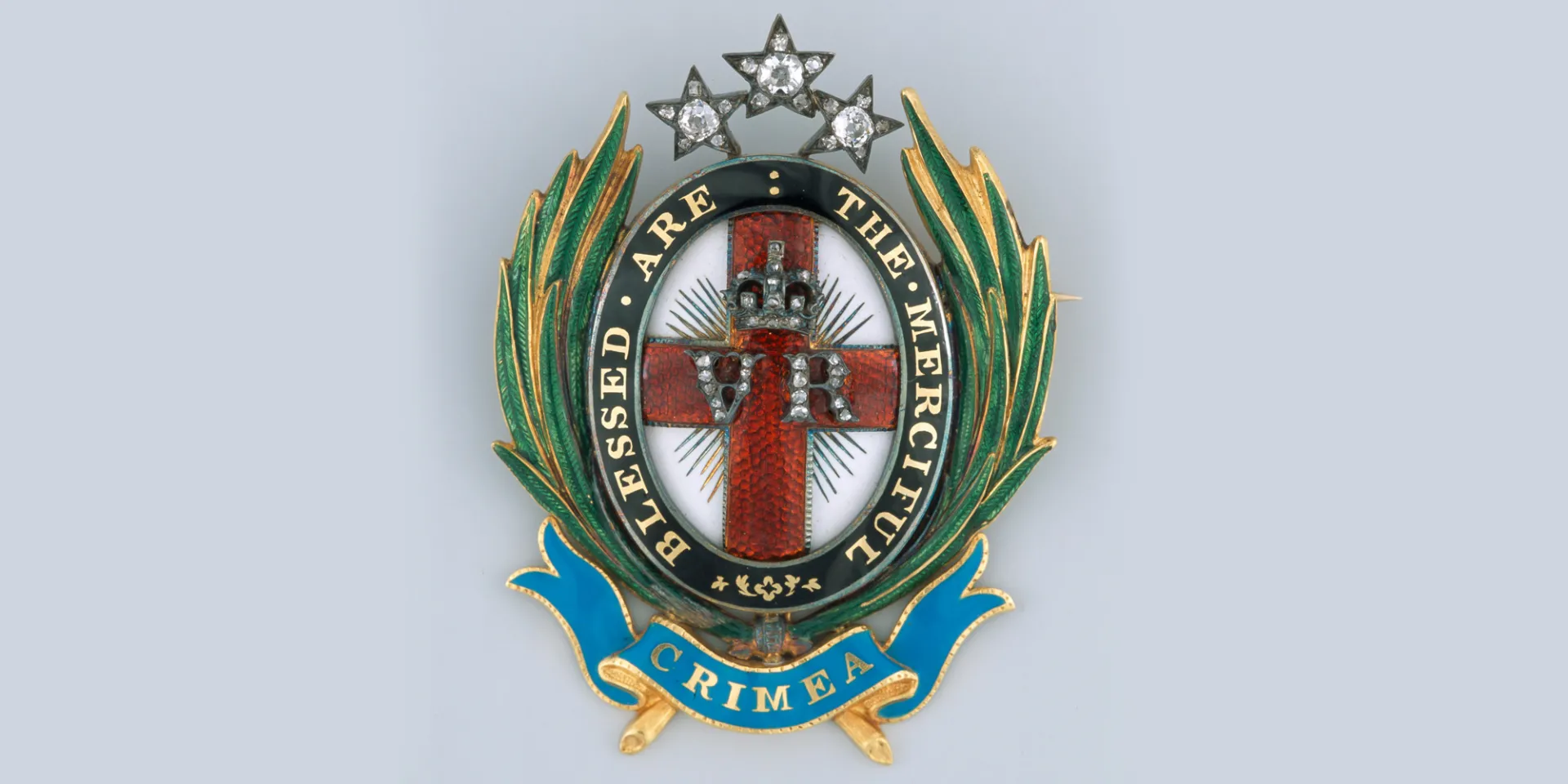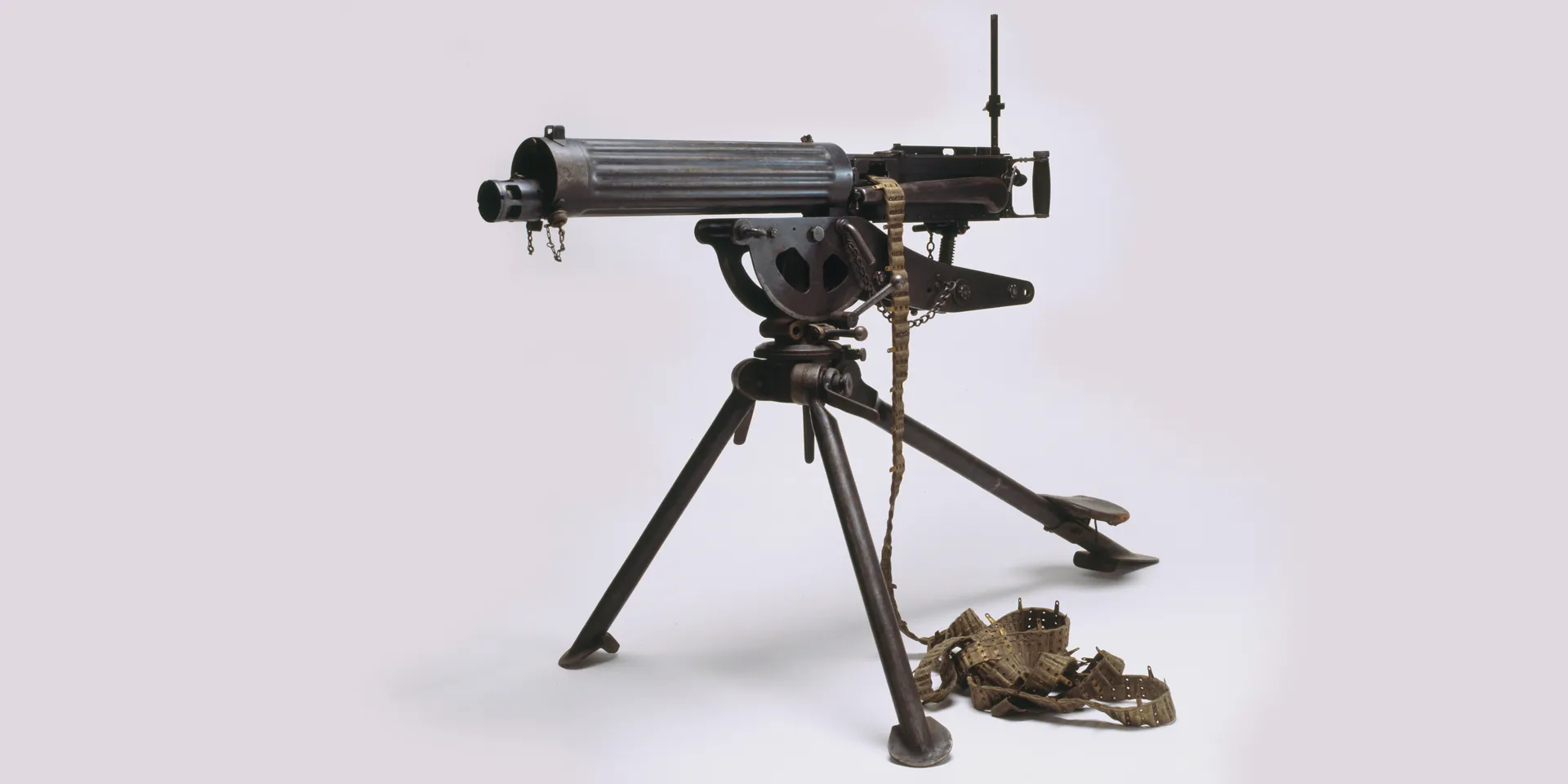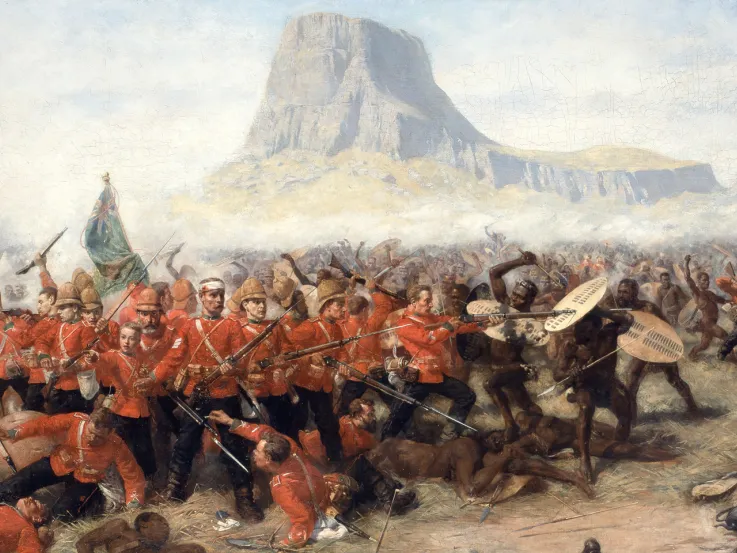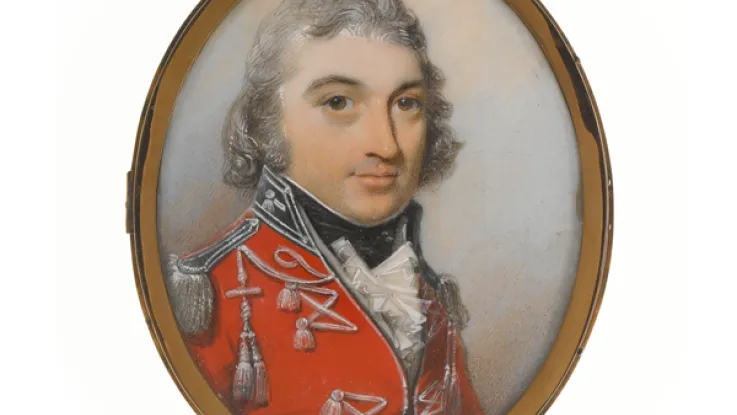A popular painting
The Battle of Isandlwana, 22 January 1879, by Charles Edwin Fripp, c1885
This painting was donated to the National Army Museum in 1960 by the 21st Special Air Service (Artists Rifles) TA. It has been almost constantly on display ever since.
The Battle of Isandlwana, fought during the Zulu War (1879), was one of the worst disasters suffered by the British Army in the late 19th century. Charles Fripp’s depiction of the 24th Regiment’s last stand symbolises how the Victorian public preferred to view colonial warfare. The painting emphasises the heroism of the soldiers rather than the fact that a well-equipped army had been defeated.
Unsurprisingly, it was the subsequent defence of the Rorke’s Drift mission station, rather than the defeat at Isandlwana, that passed into British folklore. Eleven Victoria Crosses were awarded for that legendary action.
The artist Charles Fripp was a lieutenant in the 20th (Artists’) Volunteer Battalion, The Rifle Brigade (The Prince Consort’s Own) when he painted this work. He arrived in Zululand in March 1879 as the 'special artist' for 'The Graphic' and was with the party who found the body of the Prince Imperial of France.
Although he visited the Isandlwana battlefield, he was not an eye-witness to the events and he reconstructed this scene as more heroic than the shambles it must actually have been.
A personal story
Officer’s full dress coatee worn by Captain Audley Lemprière when he was killed on 19 April 1855
The National Army Museum's collection is made up of over half a million objects. Many of them tell a personal story and give us a powerful insight into the life of individual soldiers. This coatee was given to the Museum in 1997 by the Trustees of the Middlesex Regimental Museum as part of a large regimental donation following that museum's closure in 1992.
Audley Lemprière was commissioned an ensign in the 77th (East Middlesex) Regiment in 1852 and promoted lieutenant in June 1854. The casualty rate among officers during the Crimean War (1854-56) meant that by the tender age of 20, he had already been promoted to captain.
Lemprière was one of the smallest officers in the Army. The chest measurement of his coatee is just 31 inches and the length from nape to lower edge is 30.5 inches. He was fondly referred to by the colonel of the regiment as his ‘child’. When the young officer was killed in an attack on the Russian rifle pits before Sevastopol, the colonel snatched up his body and carried it off exclaiming, ‘They shall never take my child.’
Designed by a prince
Gold enamelled brooch, presented to Florence Nightingale by Queen Victoria, 1855
This brooch and a number of important personal items relating to Florence Nightingale were originally donated to the Royal United Services Institution by the executors of her estate. It was fitting that they were transferred to the National Army Museum in 1963 because it had been her stated wish that they should be housed ‘where the soldiers could see them.’
Made of gold and enamel and set with diamonds, this brooch was manufactured by R and S Garrard and Co in 1855. Sometimes referred to as the ‘Nightingale Jewel’, its design was supervised by Prince Albert The Prince Consort. It is engraved verso with a dedication from Queen Victoria, ‘To Miss Florence Nightingale, as a mark of esteem and gratitude for her devotion towards the Queen’s brave soldiers, from Victoria R. 1855’.
The brooch was not intended to serve merely as a piece of jewellery, but rather, in the absence of a medal or established decoration suitable for presentation to such a female civilian, it stood as a badge of royal appreciation. However, Florence Nightingale rarely wore it because it looked like an order rather than a pretty jewel.
‘I need hardly to repeat to you how warm my admiration is for your services, which are fully equal to those of my dear and brave soldiers, whose sufferings you have had the privilege of alleviating in so merciful a manner. I am however, anxious of marking my feelings in a manner which I trust will be agreeable to you, and therefore send you with this letter a brooch, the form and emblems of which commemorate your great and blessed work, and which, I hope, you will wear as a mark of the high approbation of your Sovereign!’Note from Queen Victoria accompanying the brooch dedicated to Florence Nightingale — 1855

Pugri badge, 45th Rattray’s Sikhs Bengal Infantry, c1864-1900
A badge of harmony
Pugri badge, Sikh and Mohammedan Company, 45th Rattray’s Sikhs Bengal Infantry, 1864-1901
In 2013, Field Marshal Sir John Chapple GCB, CBE, donated over 8,500 pieces of insignia to the National Army Museum. These include badges, buttons, shoulder belt plates, shoulder titles and belt buckles. The Field Marshal started collecting militaria at the age of 15 and has spent over 70 years sourcing badges from around the world.
The near comprehensive collection encompasses units from the East India Company's and Indian Armies. It includes regular cavalry, infantry and support services, Auxiliary Force India units, and a selection of the Indian State Forces who served in both World Wars. The objects span over a century from the mid-19th century until Partition in 1947.
This interesting badge is evidence of the harmony that existed between the various diverse religious and racial groups that comprised the British Indian Army. The badge of the 45th Rattray's was worn by both Sikh and Mohammedan (Muslim) soldiers, with the double-edged dagger representing Sikhs and the crescent moon representing Muslims.
The origins of the 45th Rattray’s Sikh Regiment lay in the 1856 decision to raise a Corps of Military Police to control the Lower Provinces of Bengal, where a rebellion had broken out. Captain Thomas Rattray raised his Bengal Police Battalion in the Punjab, employing former soldiers of the old Sikh Khalsa Army. The battalion played an important part in suppressing the Indian Mutiny (1857-59).
A cap of distinction
Grenadier cap, other ranks’, Royal Regiment of Ireland, worn by Captain Robert Parker, c1710
This cap was donated to the National Army Museum by Royal Irish Officers Association in 1959. Following the creation of the Irish Free State in 1922, the five regiments of the British Army that recruited in southern Ireland were disbanded. These were the Royal Irish Regiment, the Connaught Rangers, the Leinster Regiment, the Royal Munster Fusiliers and the Royal Dublin Fusiliers. Collections relating to these regiments are central to the Museum's founding.
Grenadiers were the elite soldiers of the age and their brimless, highly decorated and expensive headgear distinguished them from other soldiers. This grenadier’s mitre cap is associated with Captain Robert Parker. Born in Ireland in around 1665, Parker joined an independent company of foot in his home town of Kilkenny. However, in 1685, King James II set about remodelling his Irish Army to strengthen Roman Catholic influence. In the next three years, men whose loyalty was suspect were purged, including Parker.
Following the accession of Protestant King William III in 1688, Parker re-enlisted, joining the Earl of Meath’s Regiment (later The Royal Irish Regiment). Although he soon regretted his decision, finding that ‘carrying a brown musket was but a melancholy prospect’, he resolved to make the best of it.
In reward for his actions at the Siege of Namur in July 1695, Parker was commissioned. And in 1706, he became Captain of the Regiment’s Grenadier Company, a remarkable rise from his humble beginnings.
Images of war
The taking of IJsseloord redoubt, 1585, an etching after Frans Hogenberg, published c1613
The Crookshank Collection is one of the most important print collections held by the National Army Museum and one that we hold due to the generosity of another national museum. Containing nearly 1,500 prints of battles from 1066 to 1868, it was created by Lieutenant Colonel Chichester de Wint Crookshank, who also wrote a catalogue raisonné of prints of British Military Operations, published in 1912. Crookshank served in the Royal Engineers before becoming MP for Berwick and Haddington.
The collection was the subject of an exhibition at the Royal United Services Institution in 1933. It was then kept in the Imperial War Museum until Crookshank transferred it to the British Museum’s Department of Prints and Drawings in 1944. Crookshank was an early advocate for the establishment of a national Army museum. Although he never lived to see it, we are fortunate that the British Museum saw fit to transfer this important collection to us in 1971, fulfilling his wishes.
Some of the prints are extremely rare and Crookshank took care to acquire only the best examples of each. They all bear the collector’s stamp of this great connoisseur of British military historical prints. One of the earliest contemporary etchings is from the Anglo-Spanish War (1585-1604), a view of the taking of the IJsseloord redoubt by the Flemish artist Frans Hogenberg.
The fort was situated at a strategic point near the Dutch city of Arnhem where the Rhine and IJssel rivers meet. The redoubt had been taken by the Spanish in the spring of 1585. On 6 October that year, a combined English, German and Dutch force surrounded and bombarded the fortification. The Spanish surrendered and Arnhem remained in Dutch hands until 1626, when it was retaken by the Spanish.
Held in trust for the nation
Bronze Saker, manufactured by John and Robert Owen, 1538
This saker was originally on loan to the National Army Museum before being converted to a gift by the Royal Artillery Historical Trust in 1991. The Trust looks after the heritage and traditions of the Royal Artillery. The saker is one of the earliest items in the Museum's collection.
The barrel was cast in 1538 and is inscribed, ‘Henrycus Octavus’ ‘Ihon and Robert Owyn Brethren Made This Sacer Weying 1212 Anno Dni 1538’. It is also inscribed with a Tudor rose and a monogram of King Henry VIII.
The brothers John and Robert Owen began work in 1529 at the Houndsditch gun foundry in London. They established a gun-founding dynasty, which lasted until 1603, when their last descendant was still casting ordnance.
During the 16th century, England remained a minor military power. King Henry VIII wanted military glory, and spent large sums of money to achieve it. The King amassed a large arsenal of sakers. At that time, many artillery pieces were given the names of birds; a ‘saker’ was a type of falcon.
Because of its size, weight and immobility, the saker tended to be used in a fixed role. It fired solid iron shot, weighing between 1.8 and 2.7kg (4-6lb). These would not explode on impact, but would bounce along the ground until they crashed into something.
British Army pink
Land Rover, 109 Pink Panther, 3/4 ton 4x4 utility vehicle, 1969
Nearly half of the Museum’s vehicle collection was donated by the Ministry of Defence. In 1968, the British Army bought 72 examples of the Series 2A long wheelbase Land Rovers (the 109), it was officially known as 'Truck, General Service, 3/4 Ton' or 'FV 18064'. Of the original 72 ordered, only about 20 survive, so the Museum was particularly pleased to acquire this example.
It is of a type used by the Special Air Service (SAS) in Aden, Oman and Kenya during the 1960s and 1970s. ‘Pink Panthers’ got their nickname from the colour that they were painted. When deployed, even their tyres were painted to match. This was intended to make them less visible in desert conditions. The colour worked best in the light of dawn or dusk. Originally, the fresh paint colour would have been less pink, but the pigments have changed over time.
The factory-stock Land Rovers were sent to Marshalls of Cambridge for conversion to SAS specification including their respray from the standard bronze green paint scheme. The work involved the addition of fuel tanks, heavy duty suspension, sand tyres and weapons such as a general purpose machine gun. A fully-loaded Pink Panther weighed over 6,000lb. The weight would have been higher, but the modifications also included the removal of the roof, doors and windscreen.
The Museum’s Pink Panther came into service with the British Army in July 1969, coincidentally the same year that ‘The Pink Panther Show’ was first aired on TV. The vehicle was transferred to 22 SAS in September 1981 and was struck off the military census in 1986. 'Pink Panthers' were eventually replaced by the Special Forces Land Rover Defender 110 Desert Patrol Vehicle (or DPV).
A family of influence
General Sir Henry Clinton in General Officers’ undress uniform, miniature portrait in watercolour on ivory by John Smart, 1777
The Museum is very grateful for the generosity of charities such as the Art Fund. Their financial support has enabled the acquisition of important objects which are beyond the means of the Museum's purchase grant. In addition to supporting the acquisition of items through grants, the Art Fund has also enriched the Museum's collection by acting as a conduit for the donation of artworks.
As the name suggests, miniatures are usually of a scale that can be held in the palm of the hand. Many are oval, framed in gold and with suspension loops so that they could be worn or carried. This exquisite miniature is framed and glazed with a plain gold bracelet clasp, with holes for a wrist strap. In the 18th century it was fashionable for ladies to wear portrait miniatures on bracelets. Most of the wrist straps were made of fabric but some were fashioned from the woven hair of the sitter.
Military families have always had to endure periods of separation, but in the 18th and 19th centuries portrait miniatures were often a parting gift from an officer to his wife or mother. This example shows Sir Henry Clinton, who served with the Grenadier Guards during the Seven Years War (1756-63). Clinton also distinguished himself as an aide-de-camp to Duke Ferdinand of Brunswick.
He later played a major role in the American War of Independence of (1775-83), which culminated in his appointment as Commander-in-Chief in America in March 1778. The following year he invaded South Carolina and in 1780 captured Charleston. However, after the surrender at Yorktown (1781), Clinton was replaced as Commander-in-Chief by General Sir Guy Carleton.
The Clinton military dynasty spanned more than three generations. Two of Sir Henry’s sons, William Henry Clinton and Henry Clinton the Younger, became important generals in the Napoleonic era.
An iconic machine gun
Vickers .303 inch Class C medium machine gun, c1910
Some of the Museum’s most iconic objects have been donated by their manufacturers. Commercial companies have enabled the Museum to fill gaps in its collection, including this precursor of the Vickers Mark 1 machine gun, donated by Vickers Engineering Limited in 1967.
The Vickers .303 inch Class C was a commercially-available, water-cooled machine gun which was trialled by the British Army from 1910. Following a few changes, it was adopted as the Vickers Mark 1 on 26 November 1912 and became the standard machine gun of the British and Commonwealth forces. It weighs about 28lb when empty of water and typically required a six to eight-man team to transport and operate it.
The Vickers Mark 1 was used in all theatres of the First World War (1914-18) and it was famed for its reliability. It could fire over 600 rounds per minute and had a range of 4,500 yards (or over 4km). With proper handling, the Vickers could sustain a rate of fire for hours, providing a necessary supply of fabric belts of ammunition, spare barrels and cooling water was available. It holds about 7.5 pints of water. When there was insufficient water to hand, soldiers would urinate in the water jacket to keep the gun cool!
Vickers guns were among the deadliest weapons of the Western Front and are considered one of the finest machine guns ever made. The Vickers continued to be used by the British Army until the 1960s.
A very personal donation
Frostbitten finger tips of Major Michael ‘Bronco’ Lane, lost on the ascent of Mount Everest, 1976
The Museum has received many donations from private individuals, but none of them are as personal as Major Michael ‘Bronco’ Lane’s fingers and toes. At the time of the donation, Major Lane said, ‘I don't think it was quite what they were expecting... but I haven't got any use for them anymore and I thought it would be nice to see them exhibited.’
Michael Patrick Lane, nicknamed 'Bronco', joined the British Army aged 16 in November 1961. He served initially in the 7th Parachute Regiment, Royal Horse Artillery, before being selected for the SAS in 1967. The following year, he joined the Army Mountaineering Association and between 1972 and 1975 took part in expeditions to the Canadian Arctic, the Indian Himalayas and the Nuptse range in Nepal.
In 1976, Lane joined the first all-military expedition to climb Everest. Major Lane and Sergeant John ‘Brummie’ Stokes reached the summit, but on the way down terrible weather forced them to spend the night in a snow hole. With his fellow climber suffering from snow blindness and breathing difficulties, Bronco had to remove the glove on his right hand to open their last oxygen bottle. When he did this, he knew he would probably lose his fingers to frostbite. As a result of the climb, both men also lost all of their toes.
Lane’s digits were preserved in formaldehyde and kept in the regimental mess before he donated them to the Museum in 2000. Both Lane and Stokes were awarded the British Empire Medal for the expedition.
Surrender your arms!
Adams .476 inch percussion revolver used by Lieutenant Charles Webber, Royal Engineers, about 1858
Knife, gun and ammunition amnesties have been an important means of taking dangerous weapons off the streets of Britain. Not all of the items handed in are modern. Many of them are of historic interest, so the local police forces that administer the amnesties have the power to save some from destruction and transfer them to museums. The National Army Museum has acquired nearly 750 weapons from amnesties.
This Adams percussion revolver is inscribed on the butt, ‘from Charles E. Webber Royal Engineers Esperance Jhansi 4 April 1858’. Lieutenant Charles Webber had a long and distinguished army career. He was one of the officers who led the assault on Jhansi on 3-4 April 1858 during the Indian Mutiny.
Many officers purchased their own revolvers after their much publicised appearance at the Great Exhibition in London in 1851. The Adams double-action revolver had been improved by Lieutenant Frederick Beaumont of the Royal Engineers. Beaumont-Adams revolvers were ordered by the War Department in 1855. This particular model has the Kerr rammer which dates it to post-1857. It was made by the London Armoury Company and retailed by Wilkinson.
Donating to the Collection
The National Army Museum's collection is continuously developing as new items are acquired, many through the generosity of individuals in the form of private donations.
We are currently actively collecting material relating to ordinary soldiers from the last five centuries, women who have served, and soldiers from the former British Empire and Commonwealth. We also run several active collecting programmes based around the Army today, as well as future exhibitions.
If you wish to offer us items as a donation, visit Donating to the Collection to find out more about the process.

















